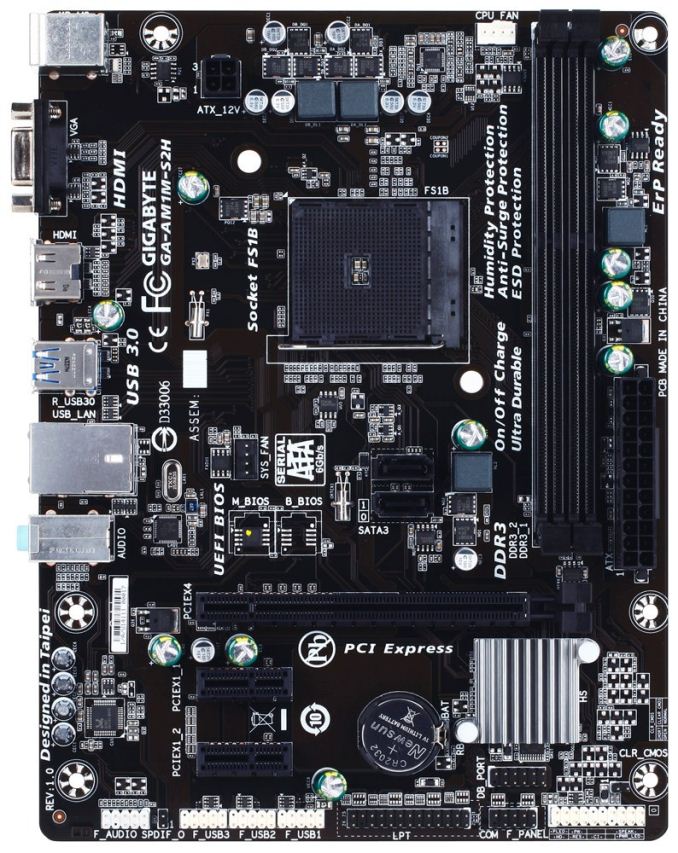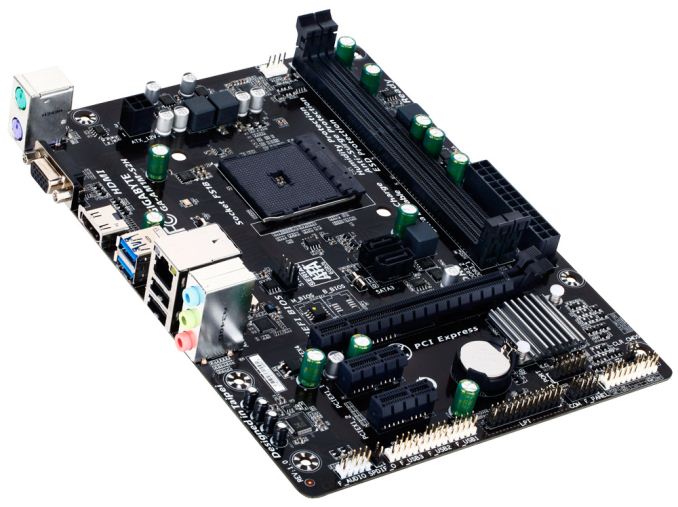The AM1 Kabini Motherboard Preview: Analyzing the Hardware
by Ian Cutress on April 19, 2014 2:00 PM ESTGIGABYTE AM1M-S2H
The motherboard AMD decided to ship with its Kabini review packs was the GIGABYTE AM1M-S2H. By being at the cheaper end of the spectrum, AMD was hoping to show just how cheap a quad core Jaguar derived system could be with one of the major motherboard manufacturers.
The GIGABYTE AM1M-S2H does the motherboard design a little more traditionally than the previous Biostar, in the sense that the DRAM slots are in the regular orientation and the 4-pin CPU power connector is also in a place beneficial for cable management:
For a larger motherboard it does seem relatively empty, however due to the low cost nature GIGABYTE has restricted the extras above the standard package. Aside from what Kabini provides GIGABYTE has equipped the AM1M-S2H with two BIOS chips for their DualBIOS topology. We get a regular Ethernet gigabit controller as well, along with a Realtek ALC887 audio codec rather than the ultra-low-cost ALC662.
Both fan headers on the motherboard are 4-pin, and because we actually have this motherboard in house to test, we can confirm that the BIOS and software are up to date with a modern platform. GIGABYTE states compatibility with 16GB DDR3 DRAM modules which Biostar does not, so we are just waiting for them to actually come to market.
The rear panel is pretty bleak, although we get a HDMI port supporting 4K UHD at 30 Hz. Given the power of a Kabini APU, gaming at that resolution might be best avoided.
| GIGABYTE AM1M-S2H | |
| Price | Link |
| Size | Micro-ATX |
| CPU Interface | FS1b |
| Chipset | Kabini |
| Memory Slots |
Two DDR3 DRAM slots supporting 32GB Single Channel, 1333/1600 MHz |
| Video Outputs |
VGA (1920x1200) HDMI (4096x2160) |
| Onboard LAN | Realtek (10/100/1000) |
| Onboard Audio | Realtek ALC887 |
| Expansion Slots |
1 x PCIe 2.0 x16 (x4) 2 x PCIe 2.0 x1 |
| Onboard SATA/RAID | 2 x SATA 6 Gbps |
| USB 3.0 | 2 x USB 3.0 (Chipset) [back panel] |
| Onboard |
2 x SATA 6 Gbps 2 x USB 2.0 Headers 2 x Fan Headers Front Audio Header Front Panel Header COM Header LPT Header S/PDIF Output Header |
| Power Connectors |
1 x 24-pin ATX 1 x 4-pin CPU |
| Fan Headers |
1 x CPU (4-pin) 1 x SYS (4-pin) |
| IO Panel |
1 x PS/2 Keyboard Port 1 x PS/2 Mouse Port VGA HDMI 2 x USB 3.0 2 x USB 2.0 1 x Ethernet (1 Gbps) Audio Jacks (ALC887) |
| Product Page | Link |
Compared to the $33 AM1ML, the GIGABYTE offers a lot for $2 more – DualBIOS, a full microATX size, gigabit Ethernet, a better audio codec, both fan headers are 4-pins and a more traditional orientation for DRAM and cable management.
We should have a full review of this motherboard in due course.














64 Comments
View All Comments
Chrispy_ - Saturday, April 19, 2014 - link
The whole concept of an expensive AM1 motherboard is ridiculous, because as metioned in the article, once the CPU+platform cost reaches about $80 you could buy an FM2 solution which would be significantly more powerful and have many more features.Asus, in this case, completely misses the point.
silverblue - Saturday, April 19, 2014 - link
Yet it would be a dual core, with a much higher TDP. None of these Kabini boards are full ATX, either, so you're not forced into a large form factor.Admittedly, I would go FM2/FM2+ as I would want the performance, but I could make a much smaller and quieter PC with Kabini for obvious reasons.
johnny_boy - Monday, April 21, 2014 - link
Exactly (about the TDP). There's still reason to go AM1 over FM2(+) purely for thermal/wattage reasons. I was eyeing a super small ITX case with 60W pico PSU for HTPC use that could also serve for NAS purposes and be always on. I wouldn't run a 65-100W FM2 chip 24/7 or for HTPC use unless I wanted to do some light gaming.Ortanon - Monday, April 21, 2014 - link
This actually insinuates that a low-energy/low-heat desktop solution has a price premium the same way a high-performance desktop solution does. That kind of makes sense on the surface, but when you think about it things don't add up. A lower-TDP solution is necessarily less performant, but higher-TDP solutions aren't necessarily loud, and the differences in power draw are often negligible in terms of energy costs.All in all, a weaker system should be cheaper. Plain and simple. When I saw that it'd be at least $75 for an AM1 CPU/mobo, I just shook my head and moved along. Also they REALLY should've figured out a way to squeeze dual-channel into the spec.
My fantasy is for an AM1 board that has nothing but RAM slots and two full mini-PCIE slots. That's it. You slide a board full of cards into a tiny-ass case and boom. No stupid cables, no nothing. Hell, there's your under-$40 mobo right there. How difficult is that? I've been waiting for that for SO MANY years, and yet...
RoboJ1M - Tuesday, April 22, 2014 - link
You forgot no daft ATX+12 connector rubbish.You just want a DC jack on the back plate and some switched converters on board.
And an HDMI and a USB port on the back.
But yeah, that's what I'm looking for as well.
Case + Mobo + CPU + Ram + Laptop PSU = Internet PC.
Ortanon - Tuesday, April 22, 2014 - link
There are already SFF PSUs so that doesn't bother me as much. It just confuses me that after so many years of having mini-PCIe/mSATA, so few mini-ITX (!) motherboards have it, and far fewer than that have two (for your WiFi + SSD scenarios).Stand-alone cases could get a LOT smaller if that one change was made, not to mention the elimination of at least two cables from the build.
Really, I'd be looking to use full-speed mSATA storage on ANY size setup. The cards don't cost extra anymore.
solos - Friday, November 20, 2015 - link
Buy a notebook with broken screen (for next to nothing) , keep the bottom case and have your wish fullfilled ;)Flunk - Sunday, April 20, 2014 - link
If you don't produce things to hit different points of the market, how will you know they won't sell? It's worked for ASUS before.Samus - Monday, April 21, 2014 - link
Asus missed the point? ASRock is the one charging $60!ntgeralt - Saturday, April 19, 2014 - link
test